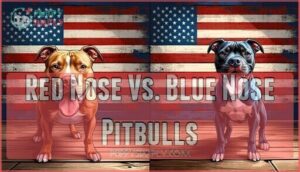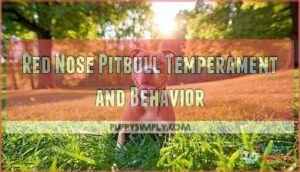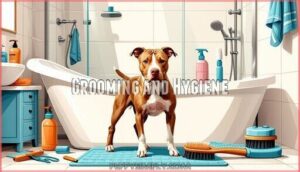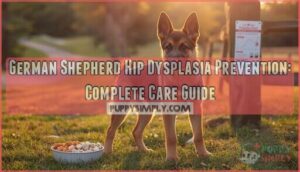This site is supported by our readers. We may earn a commission, at no cost to you, if you purchase through links.

Their copper-red nose and reddish coat come from recessive genes that typically pair with those striking amber eyes.
Don’t let their intimidating build fool you—red nose pits are total softies who bond deeply with their families when you start training and socializing them young.
You’ll want some dog experience under your belt though, since they need owners who can stay consistent with boundaries, keep up with their energy, and stick to reward-based training methods.
Sure, there are myths floating around about aggression, but these dogs are actually loving and smart family pets.
They typically live 12-14 years with good care, though you’ll want to watch for hip dysplasia and heart issues.
The real secrets to raising a well-adjusted red nose pitbull involve understanding their unique exercise needs and training approaches.
Table Of Contents
- Key Takeaways
- What is a Red Nose Pitbull?
- Red Nose Pitbull Temperament and Behavior
- Health and Lifespan of Red Nose Pitbulls
- Proper Care and Maintenance
- Training and Socialization Tips
- Adoption, Legalities, and Ownership Costs
- Frequently Asked Questions (FAQs)
- Are Red Nose Pitbulls aggressive and dangerous?
- Are Red Nose Pitbulls good with children and other pets?
- How much space do red nose pitbulls need?
- Can red nose pitbulls live in apartments?
- What climate suits red nose pitbulls best?
- Do red nose pitbulls get along with cats?
- How often should red nose pitbulls visit vets?
- Conclusion
Key Takeaways
- You’re getting a color variation of the American Pit Bull Terrier, not a separate breed—the red nose comes from recessive genes that also create amber eyes and reddish coats.
- Don’t believe the aggression myths—red nose pitbulls pass temperament tests at 87.6% and make gentle, loyal family companions when you provide proper training and early socialization.
- You’ll need to commit to serious exercise needs (at least one hour daily) and consistent positive reinforcement training, making these dogs best suited for experienced owners who can provide structure.
- Expect 12-14 years of companionship with potential health issues like hip dysplasia, plus significant costs ranging from $2,000-$4,000 annually for proper care, plus potential legal restrictions in your area.
What is a Red Nose Pitbull?
Here’s a red-nosed American Pit Bull Terrier with that distinctive copper nose, warm amber eyes, and reddish coat that sets this variety apart.
This loyal breed packs serious athleticism alongside surprising gentleness, creating devoted companions perfect for experienced dog owners ready to invest in proper training and socialization.
Breed Origins and History
When you dive into the Red Nose Pitbull’s ancient roots, you’re exploring a breed development story that spans centuries. These dogs emerged from 19th-century bulldog-terrier crosses in Ireland, establishing the founding bloodlines that shaped today’s American Pit Bull Terrier.
The Old Family Red Nose strain represents significant genetic heritage and historical significance in breed recognition. Understanding the breed history basics is essential for appreciating the intricacies of the Red Nose Pitbull’s development.
Distinctive Physical Characteristics
You’ll recognize a Red Nose Pitbull instantly by their signature copper coat and distinctive red nose. Their muscular build features a broad head, powerful chest, and those stunning amber eyes that seem to glow.
These Pitbull breed characteristics make them stand out among dog breed varieties, with their brick-shaped head and athletic frame showcasing classic breed characteristics that define this beloved Pitbull variety.
Red Nose Vs. Blue Nose Pitbulls
Here’s the thing about Red Nose and Blue Nose Pitbulls—they’re exactly the same dog underneath.
The red nose variety comes from Irish bloodlines called the Old Family Red Nose strain, while blue noses just happened to inherit a gene that changes their pigment.
Don’t let color fool you into thinking there’s a temperament difference between these Pitbull variations. Understanding the breed’s genetic color variations is essential for potential owners.
Common Myths and Misconceptions
The media loves a scary story, and Red Nose Pitbulls have become the perfect villain. These sensationalized reports create harmful stereotypes that completely ignore how individual dogs actually behave.
The result? Owners face unfair restrictions and social judgment, even though proper training consistently shows these dogs can be incredibly gentle companions.
Three major misconceptions persist:
- All Pitbulls are naturally aggressive fighters
- Red Nose varieties are more dangerous than other dogs
- They can’t be trusted around children or families
Red Nose Pitbull Temperament and Behavior
Red Nose Pitbulls are incredibly smart and devoted dogs, but their personality really comes down to how well you train and socialize them as puppies.
Understanding their true behavioral traits helps you separate fact from fiction about this misunderstood breed’s gentle, family-oriented nature.
Intelligence and Trainability
With sharp minds like steel traps, Red Nose Pitbulls showcase impressive intelligence levels that make dog training a rewarding journey. Their learning capacity shines through obedience training, where they eagerly absorb commands and demonstrate impressive problem-solving skills.
These trainability tips work best: use consistent positive reinforcement and short sessions. Understanding canine behavior helps you tap into their natural eagerness to please, making every training achievement feel like a victory lap.
Socialization Needs
Building Social Bonds with your Red Nose Pitbull starts early and never stops. These dogs crave human connection, making puppy training the perfect foundation. Proper socialization shapes confident, well-adjusted pets through consistent exposure and positive experiences.
Key socialization priorities for your Red Nose Pitbull:
- Early exposure (8-16 weeks) to various people, sounds, and environments
- Controlled Canine Interactions with vaccinated, friendly dogs
- Environmental Adaptation through regular walks in different neighborhoods
- Positive associations with children, elderly people, and strangers
- Consistent dog training sessions that reinforce calm, respectful behavior
Aggression Myths Vs. Reality
You’ve probably heard scary stories about Red Nose Pitbulls, but science tells a different story. Bite statistics show media influence creates breed stigma that doesn’t match reality. Owner responsibility matters more than genetics for aggression causes.
| Myth | Reality | Evidence |
|---|---|---|
| Pitbulls are naturally aggressive | 87.6% pass temperament tests | ATTS testing data |
| they’ve "locking jaws" | No anatomical difference | Veterinary research |
| High bite rates | Misidentified 33% of time | Mixed-breed studies |
| Born dangerous | Training/environment key | Canine temperament research |
Family Compatibility
Three key factors determine Red Nose Pitbull family compatibility: your household pets, living situation, and family dynamics.
These dogs thrive with proper dog training and behavior guidance, especially around children. Child safety requires supervised interactions and consistent boundaries.
Your family lifestyle should include active engagement and responsible pet ownership. Red Nose Pitbulls adapt well to committed families who understand their needs and provide structured environments for ideal pet care and health.
Health and Lifespan of Red Nose Pitbulls
Smart Red Nose Pitbull owners start learning about their dog’s health needs well before age eight, when those telltale gray hairs start showing up.
With proper care and regular vet visits, you can expect your Red Nose Pitbull to stick around for 12-14 years.
Just keep an eye out for hip dysplasia and heart problems that can pop up.
Common Genetic Conditions
Your Red Nose Pitbull faces several genetic conditions that responsible breeding and genetics can help prevent. Hip dysplasia affects 26% of these dogs, while allergy issues and heart problems also concern many owners.
Genetic testing and DNA research help identify risks early, making dog health monitoring essential for canine health and wellness throughout your dog’s life.
Preventive Veterinary Care
Staying ahead of health issues keeps your Red Nose Pitbull thriving. Vaccine schedules protect against deadly diseases, while parasite control prevents heartworms and fleas.
Regular dental care maintains those pearly whites—nobody wants doggy breath during cuddle time. Health screenings catch problems early, and nutrition counseling ensures proper weight.
Your veterinarian becomes your dog’s health guardian, creating tailored prevention plans.
Average Lifespan
Your Red Nose Pitbull’s life expectancy usually ranges from 12 to 14 years, though lifespan factors like genetics and health issues play vital roles.
With proper pet care and health and nutrition, many Pitbulls enjoy longer lives. The aging process brings changes, but quality senior care helps your dog thrive throughout their golden years.
Signs of Good Health
Knowing what healthy vital signs look like helps you catch problems early. Your Red Nose Pitbull’s well-being shines through clear eyes, steady energy levels, and proper weight maintenance. Regular health checks back up ideal nutrition advice and exercise needs.
Here are key indicators of good health:
- Bright, clear eyes without discharge or cloudiness
- Consistent appetite and normal eating habits
- Steady energy levels during play and exercise
- Healthy coat that’s shiny and free from excessive shedding
- Normal bathroom habits with regular, firm stools
Quality veterinary care combined with proper dog care ensures your Pitbull thrives.
Proper Care and Maintenance
Creating consistent daily routines for your Red Nose Pitbull covers three key areas: exercise, feeding, and environment. These routines become the backbone of your dog’s health and happiness over time.
Proper care really is everything for your pitbull’s long-term health. Skip the basics, and you’re setting them up for problems down the road.
Feeding and Nutrition
Building strong bones and muscles starts with smart meal planning for your Red Nose Pitbull. These muscular athletes need 18-22% protein to fuel their active lifestyle, while monitoring for food allergies that could derail your pet care routine. Adult Pitbulls need about 1.5 to 2.5 cups of dry food per day, divided into two meals, with proper feeding schedules aiding optimal nutrient needs.
| Life Stage | Protein Requirements | Special Considerations |
|---|---|---|
| Puppy (2-18 months) | 22-28% protein | Premium puppy food in multiple meals daily |
| Adult (1-7 years) | 20-22% protein | Monitor for food allergies |
| Senior (7+ years) | 18-20% protein | Reduced calories, joint aid |
| Pregnant/Nursing | 25-30% protein | Increased calcium intake |
| Active Working Dogs | 24-28% protein | Higher calorie density needed |
Dietary supplements aren’t always necessary with quality commercial foods, but consulting your vet ensures your Pitbull care and maintenance hits all the right notes for long-term dog care success.
Exercise and Activity Requirements
Your Red Nose Pitbull needs at least one hour of daily walks and vigorous physical stimulation every day. These athletic dogs crave exercise routines that challenge both body and mind.
Mix running, fetch, and mental activities like puzzle toys to prevent destructive behavior. Without proper playtime needs met, your Pitbull may become restless and difficult to manage.
Grooming and Hygiene
Weekly coat care keeps your Red Nose Pitbull looking sharp while protecting their skin health. These dog breeds shed moderately, making regular grooming essential for shedding control and overall animal welfare.
- Bathing Tips: Bath monthly or when dirty—overdoing it strips natural oils that keep skin healthy
- Nail Trimming: Clip every 2-3 weeks to prevent painful splitting and maintain proper walking posture
- Brushing Routine: Use a firm bristle brush weekly to distribute oils and minimize loose fur around your home
Safe Living Environment
Your Red Nose Pitbull needs secure home safety measures to thrive.
Install six-foot fencing with reinforced gates for proper yard security. Fence requirements include buried barriers preventing digging escapes.
These powerful dogs require noise reduction strategies and emergency planning for natural disasters.
Create a sanctuary where your companion feels protected while maintaining socialization opportunities through controlled interactions.
Training and Socialization Tips
Your red nose pitbull’s success depends on early, consistent training that builds confidence while preventing common behavioral problems.
You’ll find that positive reinforcement methods work best with these intelligent, eager-to-please dogs who respond much better to treats and praise than harsh corrections.
Positive Reinforcement Techniques
Training your Red Nose Pitbull with positive reinforcement builds trust while shaping behaviors effectively. Pitbulls respond exceptionally well to reward-based methods that encourage repeat performances. Smart praise timing makes all the difference:
- Treat Schedules: Deliver rewards within 3 seconds of good behavior
- Clicker Training: Mark exact moments when your dog gets it right
- Toy Rewards: Mix high-value treats with favorite playthings
- Consistent Praise: Use the same enthusiastic "Good!" every time
- Small Steps: Break complex commands into bite-sized victories
This foundation transforms training sessions into bonding experiences.
Early Socialization Strategies
Starting your Red Nose Pitbull’s socialization journey early transforms them into confident, well-adjusted companions. Focus on controlled exposures between 3-14 weeks when their minds are most receptive to new experiences.
| Age Range | Primary Focus | Key Activities |
|---|---|---|
| 3-7 weeks | Basic handling & sounds | Gentle touching, household noises, varied surfaces |
| 8-12 weeks | People & controlled environments | Meeting different people, car rides, vet visits |
| 12-16 weeks | Dog interactions & public spaces | Puppy classes, leashed walks, outdoor exploration |
| 16+ weeks | Ongoing reinforcement | Regular social outings, training classes, new experiences |
Puppy socialization works best through environmental enrichment—exposing your pup to different textures, sounds, and situations daily. Social learning happens when they observe calm, confident dogs moving through the world successfully.
Remember, your Red Nose Pitbull’s canine behavioral development depends on positive associations during these early weeks. Make every encounter rewarding through treats, praise, and play to build lasting confidence in your loyal companion.
Preventing Behavioral Issues
Because prevention beats correction every time, you’ll want to address behavioral triggers before they become problems. Consistent puppy training using socialization techniques helps your Red Nose Pitbull develop healthy coping mechanisms. Environmental factors play a huge role in shaping canine psychology and preventing issues.
- Watch for stress signals like excessive panting or pacing
- Redirect unwanted behaviors immediately with positive alternatives
- Create predictable routines that build confidence and security
Training for Families With Children
When kids enter the mix with your Red Nose Pitbull, you’ll need kid-friendly commands and family training methods that work for everyone.
Teaching both children and dogs household rules through parental guidance creates safer interactions. Dog ownership means establishing clear boundaries—kids learn gentle touches while your Red Nose Pitbull practices child safety tips during training and socialization.
Adoption, Legalities, and Ownership Costs
You’ll face important financial and legal considerations before bringing your red nose pitbull home, from adoption fees ranging $350-650 to potential breed restrictions in your area.
Understanding these upfront costs and local regulations helps you prepare for responsible ownership while avoiding unexpected surprises that could affect your family’s newest member.
Adoption Vs. Buying From Breeders
When choosing your Red Nose Pitbull, you’ll face two main paths. Rescue and adoption offers remarkable rescue benefits while supporting animal adoption initiatives. Here’s your breakdown:
- Adoption Process: Usually costs $350-650 with health screenings included
- Breeder Ethics: Research thoroughly—expect $2,000-3,000 from reputable sources
- Pet Insurance: Consider coverage regardless of your choice
- Ownership Costs: Budget beyond initial fees for ongoing pet ownership expenses
Legal Restrictions and Breed Bans
Traversing breed legislation can feel like walking through a legal minefield for Red Nose Pitbull owners. Over 700 U.S. cities restrict bully breeds, including American Pit Bull Terriers and American Staffordshire Terriers. These laws range from outright bans to mandatory sterilization and special licensing requirements.
However, BSL reforms are gaining momentum—100+ cities have repealed restrictions since 2018, recognizing that dog ownership laws targeting specific breeds don’t improve public safety.
Expected Costs and Expenses
Before diving into Red Nose Pitbull ownership, you’ll face significant financial commitments. Purchase prices from reputable breeders range $1,000-$5,000, while animal adoption and rescue fees cost $200-$500.
Annual veterinary costs average $480-$600, plus insurance premiums of $360-$600 yearly. Food expenses run $300-$800 annually, and grooming fees add $300-$600.
Dog ownership and responsibility requires budgeting roughly $2,000-$4,000 yearly for proper care.
Responsible Pet Ownership Requirements
Beyond costs, owning a Red Nose Pitbull means embracing animal ownership and responsibility. You’re committing to their physical and emotional well-being for life.
- Pet Insurance – Protect against unexpected veterinary care expenses
- Emergency Planning – Create action plans for medical crises or natural disasters
- Pet Friendly Housing – Secure appropriate living arrangements that welcome your dog
- Community Resources – Connect with local dog training and behavior professionals
- Ongoing Education – Stay informed about animal adoption and rescue best practices
Frequently Asked Questions (FAQs)
Are Red Nose Pitbulls aggressive and dangerous?
Like shadows cast differently by the same tree, aggression isn’t inherent to the breed itself. According to temperament tests, Pitbulls are less aggressive than Golden Retrievers!
Temperament tests reveal pitbulls are actually less aggressive than Golden Retrievers, proving breed stereotypes don’t match reality
You’ll find proper training transforms any dog’s behavior markedly.
Are Red Nose Pitbulls good with children and other pets?
You’ll find they’re excellent with kids when properly trained and socialized early. They usually adore their families, including children but need supervision and consistent boundaries due to their strength.
How much space do red nose pitbulls need?
Your furry athlete needs room to stretch their legs and burn energy. Red nose pitbulls thrive in homes with medium to large yards where they can roam freely, though apartment living works with dedicated daily exercise routines.
Can red nose pitbulls live in apartments?
You can keep these dogs in apartments if you’re committed to providing enough daily exercise.
They don’t need massive spaces but require well-organized environments and at least an hour of daily physical activity to stay happy.
What climate suits red nose pitbulls best?
Despite what you might think, your dog isn’t built for extreme temperatures.
They do best in moderate climates with temperatures between 40°F and 85°F, where their short coats won’t leave them shivering or overheating.
Do red nose pitbulls get along with cats?
You’ll need proper early socialization if you want your cat-and-dog dream team. Most pitbulls get along splendidly with cats, especially when introduced at a young age to develop lifelong friendships.
How often should red nose pitbulls visit vets?
Think of your vet visits like regular tune-ups for a well-oiled machine. You’ll want to schedule annual checkups for healthy adult dogs, with puppies and seniors needing more frequent visits every six months to catch potential issues early.
Conclusion
Take Sarah’s red nose pitbull, Max, who transformed from a shelter dog with behavioral issues into a certified therapy animal through consistent training and socialization.
Your red nose pitbull’s success depends on understanding their specific needs and providing proper care. These loyal companions aren’t naturally aggressive but require experienced owners who can meet their exercise demands and provide structured training.
With dedication, you’ll discover why red nose pitbulls make outstanding family pets when raised responsibly.
- https://articles.hepper.com/red-nose-pitbull/
- https://en.wikipedia.org/wiki/American_Pit_Bull_Terrier
- https://www.britannica.com/animal/pit-bull
- https://www.pittiechoy.com/blogs/pit-bull-breeds-and-history/red-nose-pitbulls-a-comprehensive-guide-to-this-loving-and-misunderstood-breed
- https://www.aspcapetinsurance.com/resources/pit-bull-facts/


















